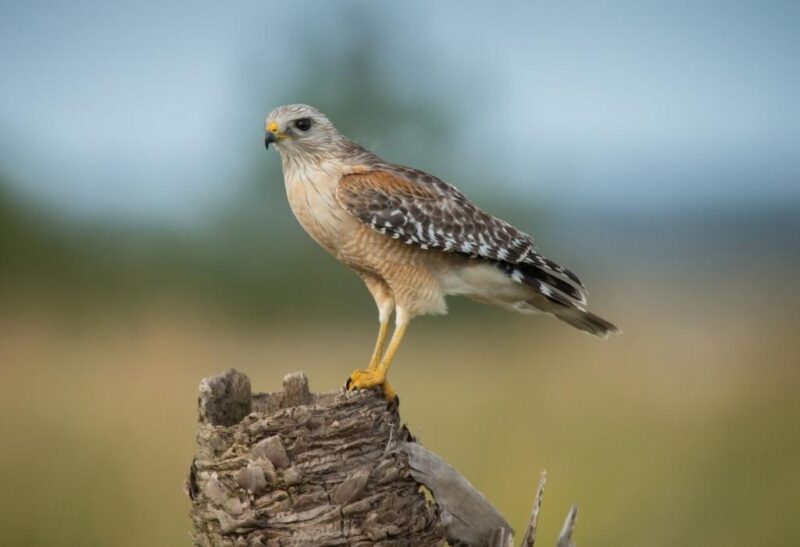Hawks are raptors or birds of prey. They have keen vision, hooked upper beaks, and strong feet with sharp talons. University in South Carolina made a checklist of birds that have visited their campus. Five hawk species are recorded.
What are the different species of hawks in South Carolina? The different species of hawks in South Carolina are the Broad-winged hawk, Sharp-shinned hawk, Northern Harrier, Red-shouldered hawk, Red-tailed hawk, and Cooper’s hawk.
These hawks are under order Falconiformes. Some of them hunt and eat live animals or even carrion.
Among the six hawks in South Carolina, the Broad-winged hawk and Red-shouldered hawk are under conservation of the South Carolina State Wildlife Action Plan.
Aside from this information, it’s best to know how to identify every hawk species that exists in South Carolina.
Table of Contents
What Is Special About Hawk Birds?
Hearing and Vision
The hearing and vision of hawk birds are eight to ten times more efficient than humans. These abilities are useful when they track their prey. There’s no doubt about their remarkable hearing ability.
Although hawks can’t move their eyes, their size is quite large for their heads. Hawks have an excellent vision as they have a neck that can move 360 degrees. Interestingly, they can see colors and things even from afar.
Strength and Power
With their strong, hooked beaks and curved talons, hawks can bite and tear flesh with no issues. These ensure success every time they capture prey. They prove to be powerful as they travel thousands of miles every year to migrate. Some of them are swift flyers as they can dive at 150 mph.
How Do I Identify a Hawk?
Here are the steps on how to identify a hawk:
- The first thing that you have to look at is the hawk’s profile and overall size.
- Then, check the overall feather pattern. You’ll likely see hawks in flight, so it’s reasonable to see them in this position. When determining the feather pattern, it should be from the head to the tail.
- Lastly, you have to check unique features to identify a certain species from others.
Are Hawks and Eagles the Same?
Although hawks and eagles are from the family Accipitridae, they are two different animals. Here are their differences and unique characteristics:
- Size – Generally, eagles are larger than hawks. For example, the size of the smallest eagle is 15 to 17 inches. This site is just the average hawk species. The largest eagle is the Philippine eagle which can grow up to 36 inches long.
- Wingspan – Eagles have larger wingspans than hawks. An average hawk has 15 to 20 inches, but a ferruginous hawk has a wingspan of 60 inches. Even the Great Nicobar serpent eagle has a wingspan of 33 inches; most eagle species have 78 inches to 90 inches. Some may even have a wingspan of 96 to 108 inches.
- Strength – The Eagles have an edge on this part since they’re larger than the hawks. Hawks may have a grip strength of 200 psi due to their talons. The grips of huge eagles are doubled to 400 psi. While hawks can lift around 4 pounds of prey, eagles can carry 20 pounds or triple their weight.
- Diet – The only difference in the diet of hawks and eagles is that the latter can hunt for larger mammals. They’re after rabbits, rodents, squirrels, and small birds.
- Sounds – Hawks give off hoarse, screeching sounds, and you can hear high-pitched piping sounds or chirps from eagles.
6 Species of Hawks in South Carolina
Broad-Winged Hawk
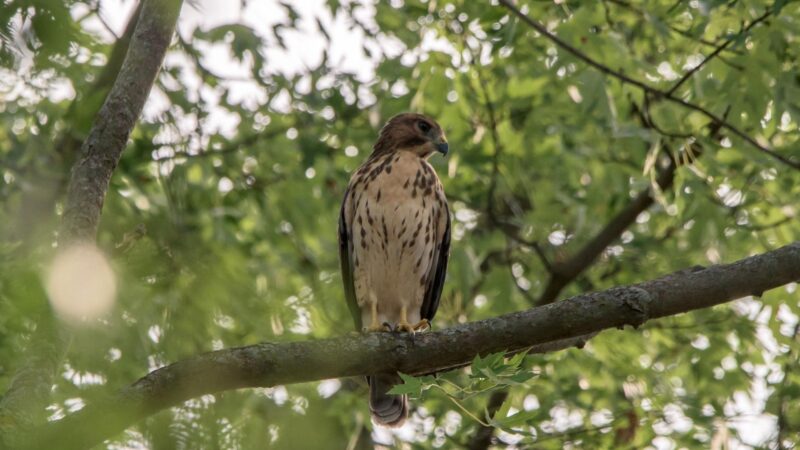
Broad-winged hawks end their isolation when migration comes. They fly with other raptors on a migratory journey.
Specifically, they join a kettle or a flock of thousands of birds. This is done so the birds can save energy when flapping their wings as they need to travel far.
- Scientific Name: Buteo platypterus
- Appearance: This is a small, stocky hawk with a dark brown back. In contrast, the underside is pale with horizontal barring.
- Color: Dark brown, dark gray, black, white
- Lifespan: 12 to 18 years
- Habitat: Deciduous or mixed forest
- Length: 34 to 44 cm
- Weight: 265 to 560 grams
- Wingspan: 81 to 100 cm
- Diet: Insects, birds, mammals, amphibians, reptiles
- Place of Origin: Nearctic and Neotropical regions
- Characteristics: Migratory; motile; solitary; territorial; diurnal
Sharp-Shinned Hawk
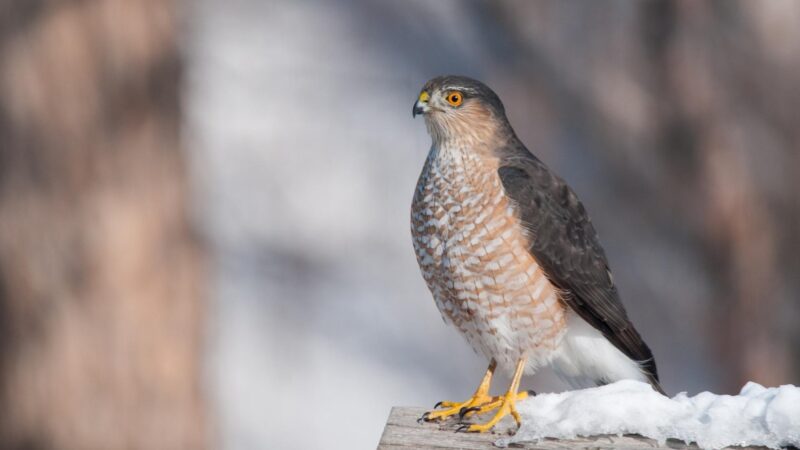
Even though they’re known as solitary, Sharp-shinned hawks create a small group when migrating. During flights, they use their tails for steering. They’re notably territorial during breeding season as they call, chase, and attack any intruders.
- Scientific Name: Accipiter striatus
- Appearance: This is the smallest accipiter species in North America. The upper part of its body is from bluish-gray to dark color akin to slate. However, the color of the crown is darker. This hawk has short, rounded wings.
- Color: Bluish-gray, brown, white
- Lifespan: Up to 19 years
- Habitat: Aspen, fir, and pine forests
- Length: 24 to 34 cm
- Weight: 87 to 218 grams
- Wingspan: 53 to 65 cm
- Diet: Birds, insects, mammals
- Place of Origin: Nearctic and Neotropical regions
- Characteristics: Motile; migratory; diurnal; territorial; solitary
Northern Harrier
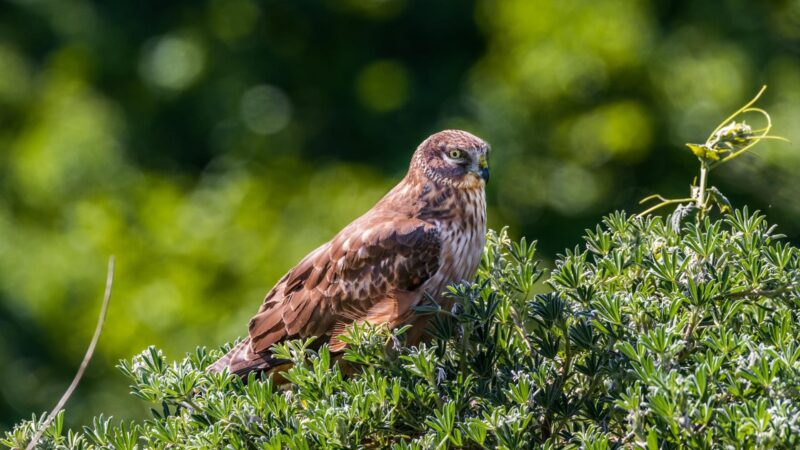
A northern harrier can do other things aside from flying. It can walk and hop too. These abilities ensure catching prey and retrieving nestling or nest materials to be successful.
Northern Harriers fly low and slow and occasionally soar. The male ones are more agile than the females.
- Scientific Name: Circus cyaneus
- Appearance: What makes Northern Harriers unique are the special feathers that are around their faces. It’s like a disc that projects the sound to their ears. When in flight, a white rump patch is noticeable. The wings are in dihedral form when gliding.
- Color: Gray, brown
- Lifespan: Up to 16 years
- Habitat: Open places like meadows, fields, savannas, upland prairies, marshes, desert steppe, and agricultural areas
- Length: 41 to 50 cm
- Weight: 290 to 600 grams
- Wingspan: 340 to 384 cm
- Diet: Amphibians, other birds, reptiles, mammals
- Place of Origin: Nearctic, Oriental, Holarctic, and Palearctic regions
- Characteristics: Migratory; motile; diurnal
Red-Shouldered Hawk
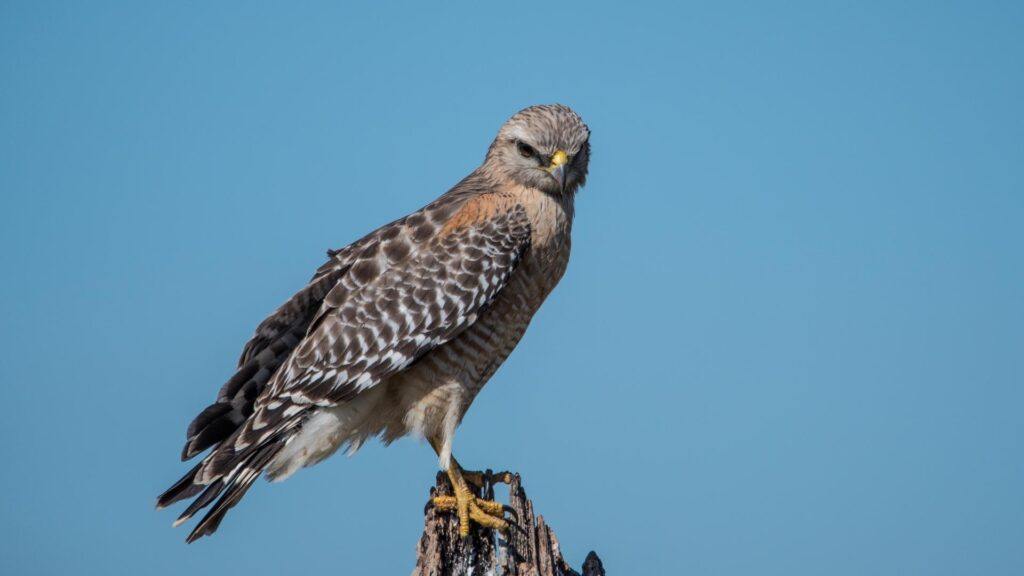
There’s no doubt that red-shouldered hawks are solitary. They don’t form a flock to find warmth during winter days. Most of them don’t migrate as they prefer to stay in one place all the time.
- Scientific Name: Buteo lineatus
- Appearance: Since this is a large hawk species, it’s expected to have large, broad wings, a heavy body, and a relatively long tail. It’s brown on the back and reddish underneath. Its upper wings are reddish too, but lighter.
- Color: Brown, dark brown, reddish
- Lifespan: Up to 19 to 20 years
- Habitat: Swamps, deciduous or mixed-deciduous conifer forests
- Length: 43 to 61 cm
- Weight: 550 to 700 grams
- Wingspan: 92 to 107cm
- Diet: Amphibians, birds, insects, reptiles, mammals, birds, aquatic crustaceans
- Place of Origin: Nearctic region
- Characteristics: Solitary; diurnal; sedentary; motile
Red-Tailed Hawk
Since a red-tailed hawk is a large, formidable bird, it has a few predators that only pursue its eggs and nestlings. It stays in the same territory for many years. The female red-tailed hawk is more aggressive than its male counterpart in protecting its nest.
- Scientific Name: Buteo jamaicensis
- Appearance: A red-tailed hawk can either light auburn or deep brown colors. It has a brownish-red tail which is the basis of its name. The belly has a lighter color than the rest of the body. Its cere, feet, and legs are yellow.
- Color: Brownish red, deep brown, light auburn
- Lifespan: 28 to 29 years
- Habitat: Wide range of habitats in different altitudes (plains, grasslands, scrub desert, tropical rainforests, agricultural fields, deciduous and patchy coniferous woodlands)
- Length: 45 to 65 cm
- Weight: 795 to 1,224 grams
- Wingspan: Around 122 cm
- Diet: Birds, reptiles, mammals
- Place of Origin: Nearctic region
- Characteristics: Territorial; motile; diurnal; migratory
Cooper’s Hawk
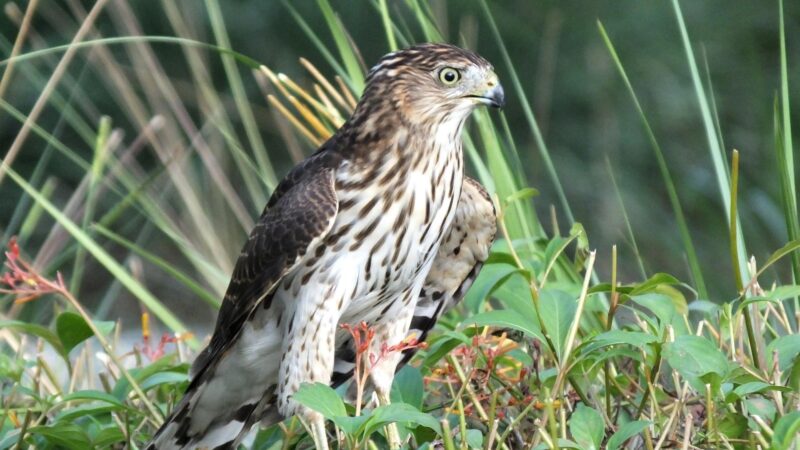
Being a swift flier, it’s easy for Cooper’s hawk to pass through its heavily vegetated habitat. It’s amazing how it can have a rapid wing beat. When it comes to hunting food, it takes time perching on a tree and waiting to ambush its prey.
- Scientific Name: Accipiter cooperii
- Appearance: For a medium-sized bird, Cooper’s hawk has a long and lean body. The back is bluish-gray with a tail that has black and white bands. It has a dark crown that separates from the lighter nape.
- Color: Blackish, blue-gray, white
- Lifespan: 12 to 20 years
- Habitat: Woodlands, deciduous and mixed forests
- Length: 35 to 50 cm
- Weight: 280 to 566 grams
- Wingspan: 75 to 94 cm
- Diet: Reptiles, mammals, amphibians, other birds
- Place of Origin: Nearctic and Neotropical regions
- Characteristics: Territorial; solitary; diurnal; migratory; motile
Frequently Asked Questions
What Attracts Hawks in Your Yard?
Food, water, perches for hunting, cover, and nest sites attract hawks in your yard.
How Long Do Hawks Stay in One Area?
Some hawks would stay in a certain place for a long time. In winter, some of them stay in one area for a week or two before leaving for another destination.
Where Do Hawks Sleep?
Hawks sleep in different perches, such as trees or tall utility poles.
What Time of the Day Are Hawks Most Active?
Since hawks are diurnals, they’re most active in the daytime.
Summary
You’ve learned about the common hawk species in South Carolina. It’s easy to think of them as there are only six. Apart from distinguishing these hawk species, you can tell them apart from other kinds of birds.
You’re now particular about appearance, behavior, characteristics, and other things related to hawks. It won’t be hard to find them as they’re active during the day.
Related: 9 Hawks in Michigan | All You Need to Know!
List of Sources
Hawks. Indiana Department of National Resources.
Kirschbaum, K., Ivory, A. (1999). Buteo platypterus. Animal Diversity Web.
Camfield, A. (2004). Accipiter striatus. Animal Diversity Web.
Limas, B. (2001). Circus cyaneus. Animal Diversity Web.
Kirschbaum, K., Miller, S. (2000). Buteo lineatus. Animal Diversity Web.
